|
Engineering & Research Corporation (ERCO) in World War Two
Riverdale, MD
1930-1954 as ERCO
1954-1957 as the Flight
Simulation Division of American Car and Foundry Corporation (ACF)
1957-1963 merged with the Nuclear Energy Products Division of ACF and
became Nuclear Products, ERCO Division
1963-The ERCO Flight Simulation portion of ACF was sold to General Precision Equipment Corporation.
In 1954 General Precision had purchased Link Aviation.
Currently, these two former flight simulation companies are part of CAE-
L3Harris Military Training
This page updated 9-4-2022.
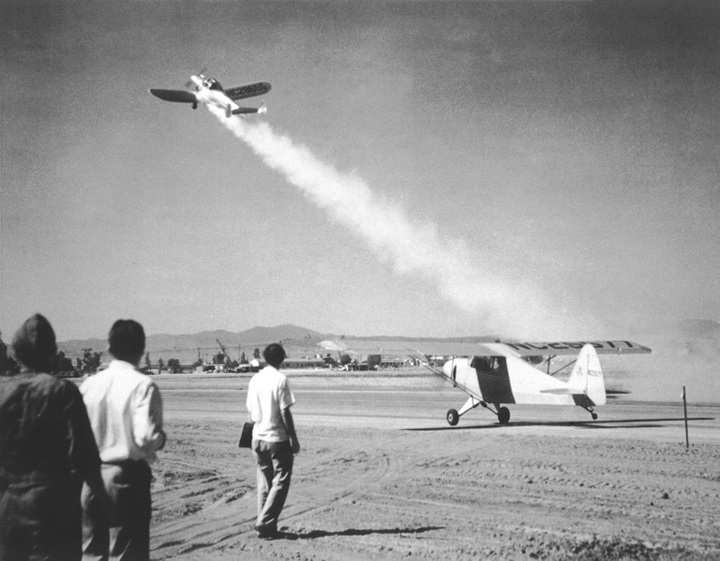
How cool is this? On August 12, 1941,
Engineering & Research Corporation Ercoupe serial number 11 climbs into
the sky using rocket assisted take-off. This was the first
American aircraft to test this new technology. This occurred at
March Field, CA. Ercoupe serial number 11 was one of 114 that were
built between 1940 and early 1942 when civilian aircraft production was
halted in the United States.

The Engineering & Research Corporation is
best known for the design and production of its Ercoupe. The
aircraft can be identified by its twin tail and nose wheel landing gear,
which was very unusual for an aircraft before World War Two.
Author's photo.
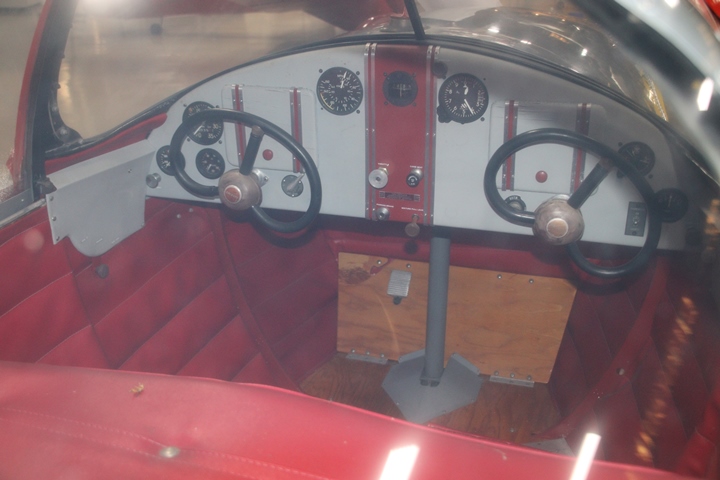
However, it was the lack of rudder pedals in the cockpit that set this
aircraft apart from any other aircraft. The Ercoupe was designed
with the rudder and ailerons tied together so that the aircraft always
made a coordinated turn. The Ercoupe was described in its Civil
Aeronautics Administration certification as being "characteristically
incapable of
spinning." Author's photo.
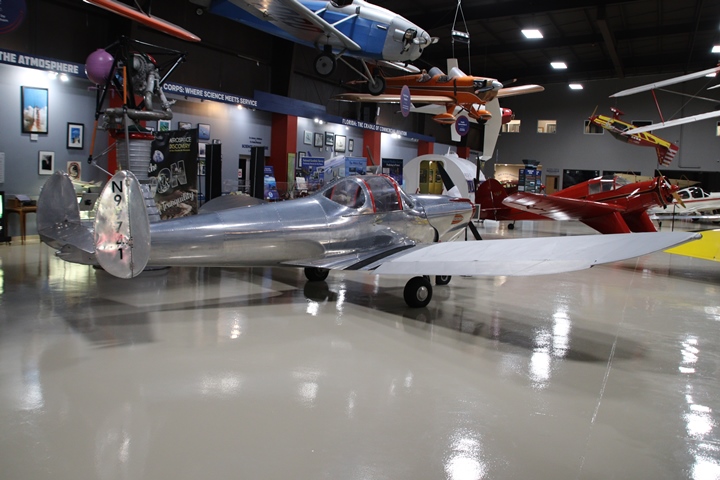
This 1946 example is part of the
Florida Air Museum and is serial number 2364. Author's photo.
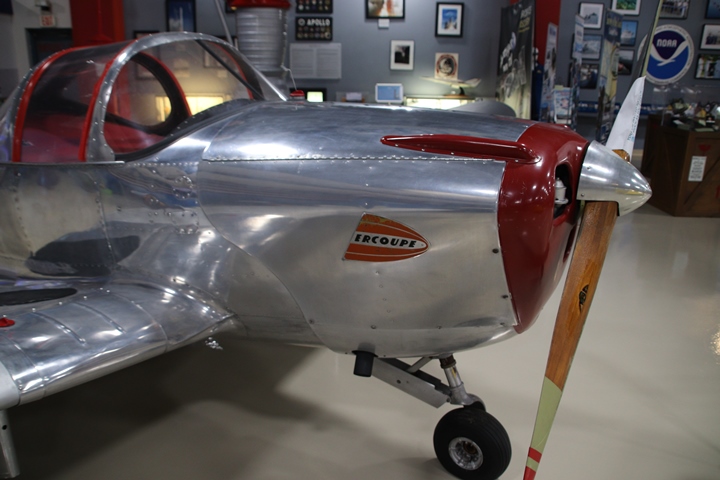
Author's photo.
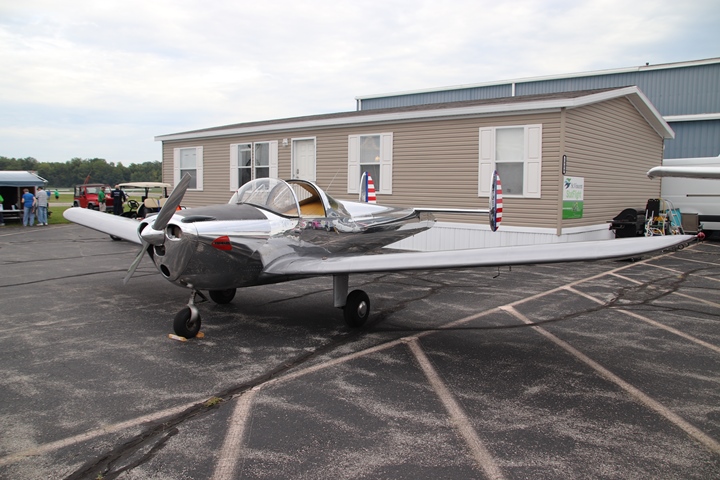
This 1946 Ercoupe was on display at the
Marion, IN Fly-in/Cruise-in. Author's photo added 9-4-2022.
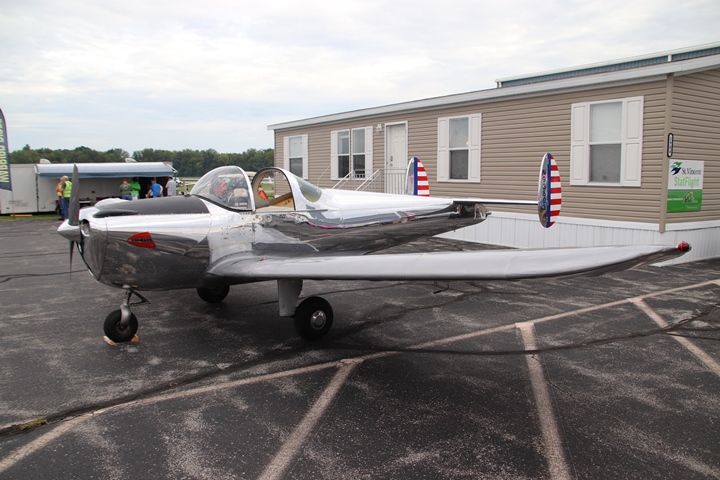
This aircraft is serial number 1126.
Author's photo added 9-4-2022.
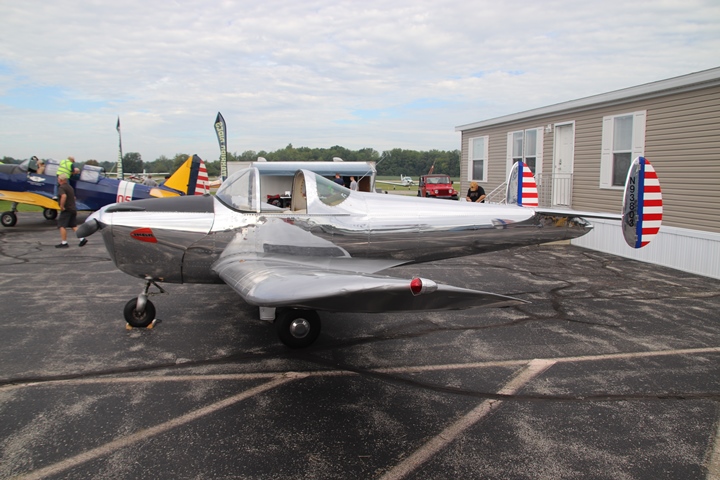
Author's photo added 9-4-2022.
In 1930, Henry Berliner formed the Engineering
& Research Corporation in Washington, DC. In 1937, Berliner moved his company
to Riverdale, MD where he built and plant and created a small airport.
The company's major product was the Ercoupe. Immediately after
World War Two, the huge demand for small civilian aircraft caused ERCO
to build the Ercoupe with a three shift operation that produced over 30
aircraft per day. Over 4,000 of the aircraft were produced in
1946. However, in 1947 the demand for civilian aircraft dropped
and Henry Berliner, chairman of the board of ERCO, sold the Ercoupe
product line to Sanders Aviation, which had been selling the Ercoupes
for ERCO. The aircraft continued to be built in the ERCO plant by
Sanders Aviation. The last of 5,140 Ercoupes rolled off the
Riverdale, MD assembly line in 1954.
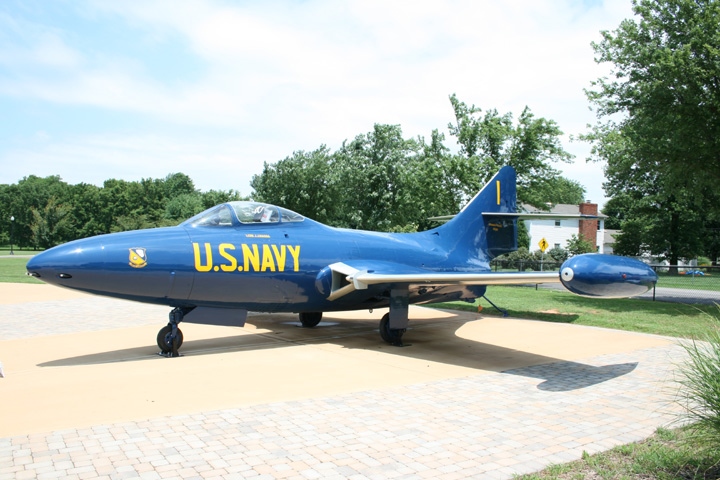
In 1949, Engineering & Research Corporation began the development and
production of flight simulators. One of the first flight
simulators built at the request of the Office of Naval Research was for
the Grumman F9F Panther. This request by the Navy resulted in a
new product line for ERCO. After several different owners, the
ERCO flight simulation business is currently part of L3Harris.
Author's photo.
Engineering & Research Corporation World
War Two Products: During World War Two, ERCO employed 4,000
persons, making it the largest wartime employer in Prince George's
County, MD.
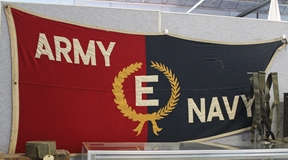
Engineering & Research Corporation won the
Army-Navy "E" Award five times during World War Two.
ERCO had a total of $52,130,000 in major
American military and foreign contracts during World War Two. $36,286,000,
or 70% of the contracts, were for aircraft gun turrets for the U.S.
Navy. The company also produced propeller blades for both the U.S.
Army and Navy. ERCO also made radio equipment for the Navy and
machine tools for the Army. It was able to convert its aircraft
manufacturing expertise into other products that helped win World War
Two.
Table 1 - Engineering & Research
Corporation's Major World War Two Contracts
The information below
comes from the "Alphabetical Listing of Major War Supply
Contracts, June 1940 through September 1945." This was
published by the Civilian Production Administration, Industrial
Statistics Division. |
|
Product - Customer |
Contract Amount |
Contract Awarded
|
Completion
Date |
| Clubs Propeller
Test - Navy |
$81,000 |
6-1940 |
11-1941 |
| Airschrews -
Foreign |
$88,000 |
10-1940 |
11-1940 |
| Propeller Test
Blades - Navy |
$262,000 |
3-1941 |
9-1942 |
| Clubs Propeller
Test - Navy |
$310,000 |
5-1941 |
7-1942 |
| Clubs Test - Navy |
$218,000 |
9-1941 |
10-1942 |
| Antennas - Navy |
$79,000 |
12-1941 |
2-1942 |
| Radio Equipment -
Navy |
$147,000 |
12-1941 |
3-1942 |
| Blades
Propeller - Army |
$229,000 |
2-1942 |
8-1942 |
| Blades
Propeller - Navy |
$90,000 |
3-1942 |
1-1943 |
| Tools Machine -
Army |
$160,000 |
3-1942 |
7-1943 |
| Propeller
Assemblies - Army |
$212,000 |
4-1942 |
7-1943 |
| Tools Machine -
Army |
$61,000 |
4-1942 |
10-1942 |
| Airplane
Equipment - Navy |
$65,000 |
5-1942 |
12-1942 |
| Tools
Machine - Army |
$191,000 |
6-1942 |
4-1943 |
| Tools Machine -
Army |
$100,000 |
6-1942 |
3-1942 |
| Propeller Blade
Assem - Army |
$1,097,000 |
9-1942 |
8-1943 |
| Tools
Machine - Army |
$85,000 |
9-1942 |
3-1943 |
|
Airplane Equipment - Navy |
$2,761,000 |
9-1942 |
6-1943 |
| Airplane
Equipment - Navy |
$653,000 |
10-1942 |
6-1943 |
| Radio Parts -
Navy |
$67,000 |
11-1942 |
1-1943 |
| Communication
Equipment - Navy |
$71,000 |
1-1943 |
5-1943 |
| Turrets - Gun -
Navy |
$221,000 |
3-1943 |
12-1943 |
| Airplane Prop
Assemblies - Army |
$1,285,000 |
6-1943 |
6-1944 |
| Airplane Gun Turrets - Navy |
$11,088,000 |
8-1943 |
2-1945 |
| Radar Antennaes -
Navy |
$240,000 |
8-1943 |
4-1944 |
| Radar Antennas -
Navy |
$446,000 |
8-1943 |
12-1943 |
| Spherical Gun
Turrets - Navy |
$1,810,000 |
8-1943 |
2-1944 |
| Engineering
Services - Navy |
$202,000 |
8-1943 |
7-1944 |
| Gun Turrets -
Navy |
$4,951,000 |
9-1943 |
7-1944 |
| Propeller Blade
Assys - Army |
$262,000 |
11-1943 |
7-1944 |
| Gun Turrets M2605
H2 - Navy |
$6,312,000 |
2-1933 |
10-1945 |
| Radar Antennas -
Navy |
$123,000 |
5-1944 |
12-1944 |
| Antenna Maint
Kits - Navy |
$262,000 |
7-1944 |
1-1945 |
| Engineering
Services - Navy |
$68,000 |
7-1944 |
6-1945 |
| Airplane Turrets - Navy |
$58,000 |
9-1944 |
10-1944 |
| Airplane Turrets - Navy |
$2,557,000 |
10-1944 |
8-1945 |
| Airplane Turrets - Navy |
$2,105,000 |
10-1944 |
5-1945 |
| Radio Equipment -
Navy |
$100,000 |
12-1944 |
9-1945 |
| Airplane Gun Turrets - Navy |
$2,781,000 |
1-1945 |
9-1945 |
| Turret Trainers -
Navy |
$113,000 |
1-1945 |
5-1945 |
| Rocket Launchers
- Navy |
$5,337,000 |
1-1945 |
9-1945 |
| Airplane Gun Turrets - Navy |
$4,403,000 |
2-1945 |
2-1946 |
| Airplane
Equipment - Navy |
$100,000 |
2-1945 |
12-1945 |
| Airl Turret
Models - Navy |
$69,000 |
6-1945 |
10-1945 |
| Total |
$52,130,000 |
|
|
Table 2 - Engineering & Research
Corporation's Major World War Two Aircraft Gun Turret Contracts
The information below
comes from the "Alphabetical Listing of Major War Supply
Contracts, June 1940 through September 1945." This was
published by the Civilian Production Administration, Industrial
Statistics Division. |
|
Product - Customer |
Contract Amount |
Contract Awarded
|
Completion
Date |
| Turrets Gun -
Navy |
$221,000 |
3-1943 |
12-1943 |
| Airplane Gun Turrets - Navy |
$11,088,000 |
8-1943 |
2-1945 |
| Spherical Gun
Turrets - Navy |
$1,810,000 |
8-1943 |
2-1944 |
| Gun Turrets -
Navy |
$4,951,000 |
9-1943 |
7-1944 |
| Gun Turrets M2605
H2 - Navy |
$6,312,000 |
2-1933 |
10-1945 |
| Airplane Turrets - Navy |
$58,000 |
9-1944 |
10-1944 |
| Airplane Turrets - Navy |
$2,557,000 |
10-1944 |
8-1945 |
| Airplane Turrets - Navy |
$2,105,000 |
10-1944 |
5-1945 |
| Airplane Gun Turrets - Navy |
$2,781,000 |
1-1945 |
9-1945 |
| Airplane Gun Turrets - Navy |
$4,403,000 |
2-1945 |
2-1946 |
| Total |
$36,286,000 |
|
|
|
Table 3 - Engineering & Research
Corporation's Major World War Two Aircraft Gun Turret Production |
|
Designation |
Type |
Aircraft |
Quantity |
Comments |
| 250SH-1,2 |
Twin .50 Bow
Turret |
PB4Y-1 |
866 |
977-111 |
| 250SH-3 |
Twin .50 Bow
Turret |
PB4Y-2 |
736 |
|
| Sub Total |
Bow Turret |
|
1,602 |
|
| 250TH-1 |
Twin .50
Starboard Teardrop Turret |
PB4Y-2 |
736 |
|
| 250TH-1 |
Twin .50 Port
Teardrop Turret |
PB4Y-2 |
736 |
|
| Total |
All Types |
|
3,074 |
|
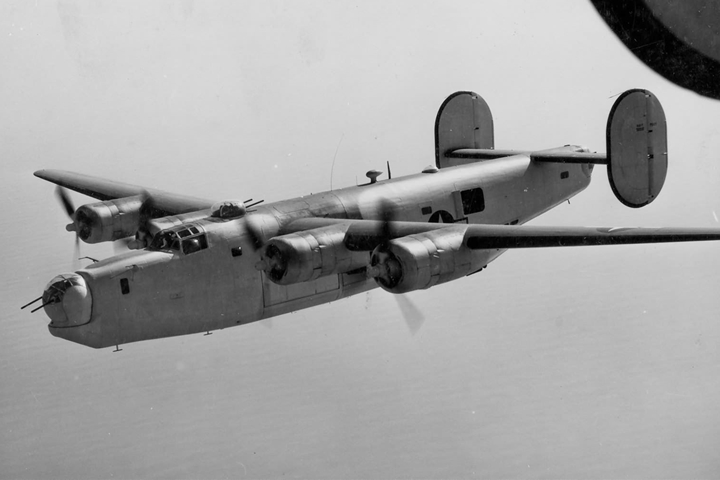
The PB4Y-1 was a naval version of the
Army Air Forces B-24. The most visible difference between the two
aircraft was the replacement of B-24 bow turrets with the ERCO 240SH-1,
2. At the beginning of World War Two, the U.S. Navy relied on
flying boats and amphibious aircraft like the PBY Catalina and the PBM
Mariner. As the war progressed and island air bases became
available in the Pacific Theater of Operations, the use of long range
land based patrol aircraft became feasible. At the same time, long
range, land based patrol planes were needed to help defeat the U-boat
menace in the North Atlantic. The PB4Y-1 was an expedient first
step to do this. Photo courtesy of World War Photos.
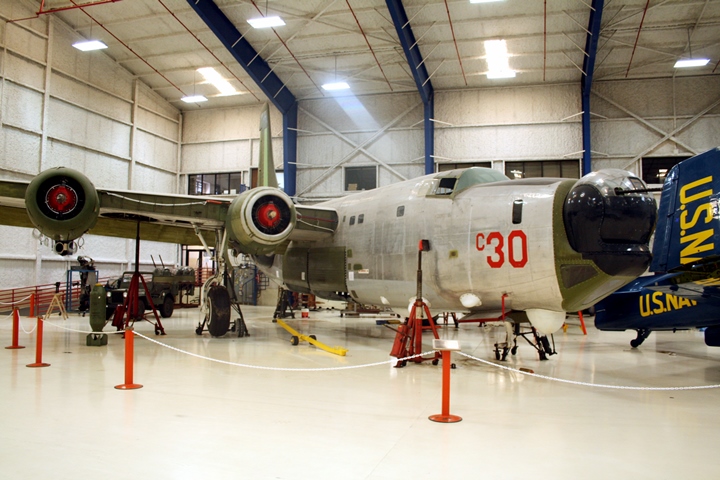
In 2009 I was at the Lone Star Flight Museum
in Galveston, TX. During my visit, I took several photographs of
the museum's PB4Y-2. This was the first PB4Y-2 I had ever seen,
and I found the gun turrets to be most interesting. The bow turret and side
turrets were of the types I had not seen before. Thirteen years
later, I was able to find these photos in my archives for use in this
webpage on ERCO. Author's photo.
At the time, the PB4Y-2 was registered as a
flyable aircraft but had been severely damaged by the storm surge of
salt water from Hurricane Ike in 2008. Work was ongoing to make
the aircraft air worthy again. This was not to be. In 2015
as the Lone Star Flight Museum moved to a location not so susceptible to
hurricane damage in Houston, the PB4Y-2 was sold to the Pima Air & Space
Museum. There the aircraft was restored to excellent static
display condition.
The PB4Y-2 was the U.S. Navy's ultimate long-range, land-based patrol aircraft in World War Two. The basic B-24
fuselage was stretched for more crew space on long-range missions.
It also allowed room for a second dorsal turret. The twin vertical
stabilizers were replaced with a single large vertical stabilizer.
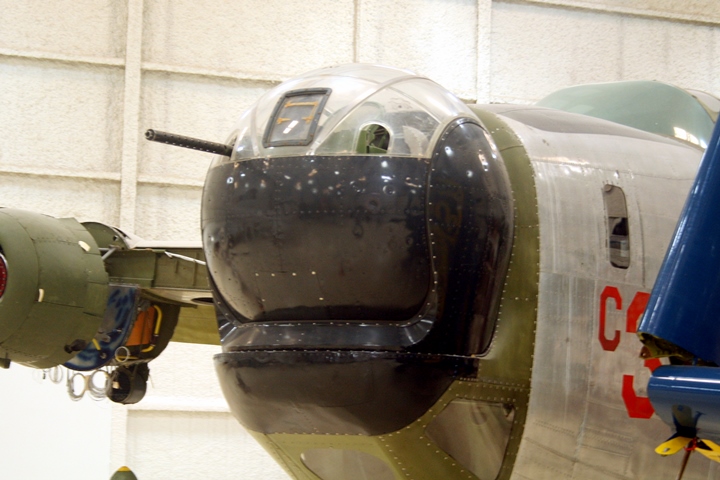
This is one of 736 ERCO 250SH-3 ball turrets
that armed the bow of the PB4Y-2. The ERCO 250SH-1 and 250SH-2
ball turrets were used on the earlier PB4Y-1. Note how conformal
and tight the fit is between the turret and the aircraft. This was
not the case in many installations of other models of bow turrets on the
B-24. The tight fit as shown here did not allow a lot of cold air
to enter the aircraft. This is made possible by the turret's
configuration being almost perfectly spherical. It is also more
aerodynamic than other bow turrets for the B-24. It is
understandable why the Navy chose this turret to equip its PB4Y series
long-range land-based patrol aircraft. Most likely, the design and
manufacture of the ERCO bow turret was requested by the U.S. Navy after being
dissatisfied with the other available bow turrets. The down
side to this ball turret is that it has a cramped working space for the
gunner. Author's photo.
The ERCO 250SH-3 had an elevation range from
-70 to +85 degrees. In azimuth, its range of movement was +/-80
degrees. It was hydraulically powered and had 1-1/2 inches of
bullet proof glass and 1/2 inch of armor to protect the gunner. It
was equipped with a Mark 9 gun sight.
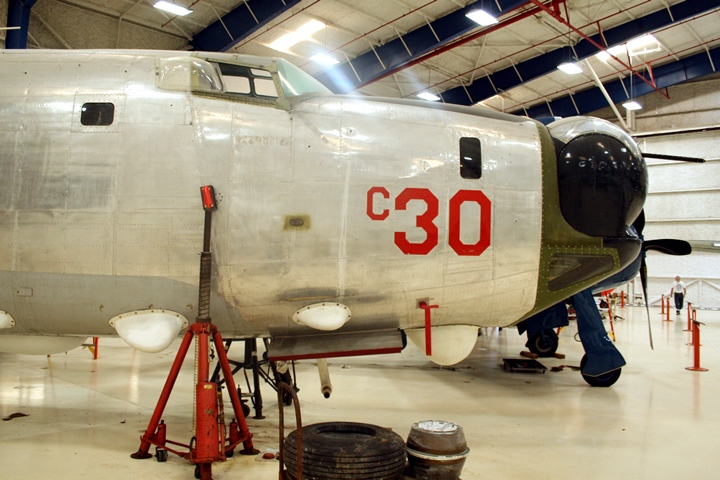
The PB4Y-2 was up on jacks when I visited.
The nose gear has been removed from the aircraft for repair.
Author's photo.
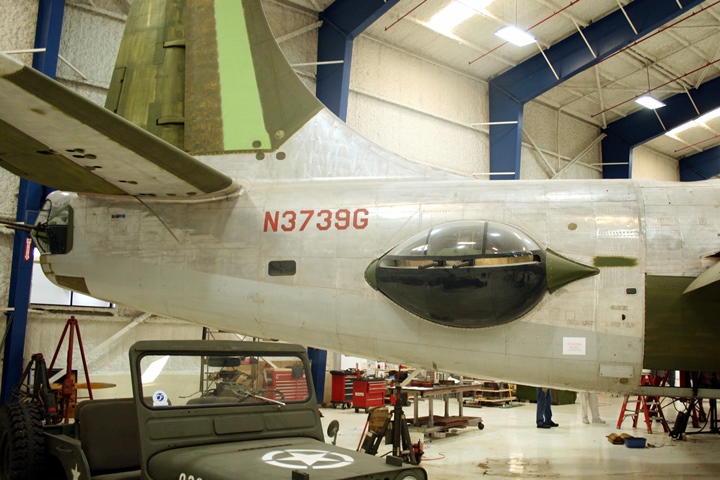
The starboard side turret for the PB4Y-2 was
the ERCO 250TH-1. The turret for the port side of the aircraft was
the ERCO 250TH-2. ERCO produced 736 of each type plus spares
during World War Two. Author's photo.
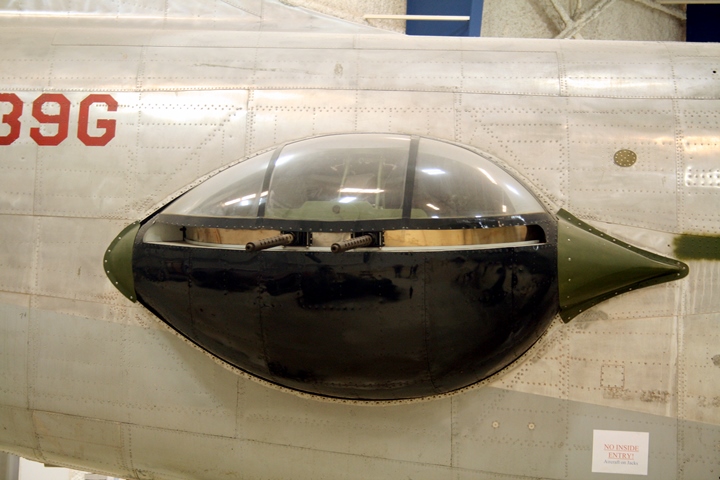
The PB4Y-2 was the only American aircraft to
be equipped with twin .50 caliber machine guns for its waist turrets.
Author's photo.
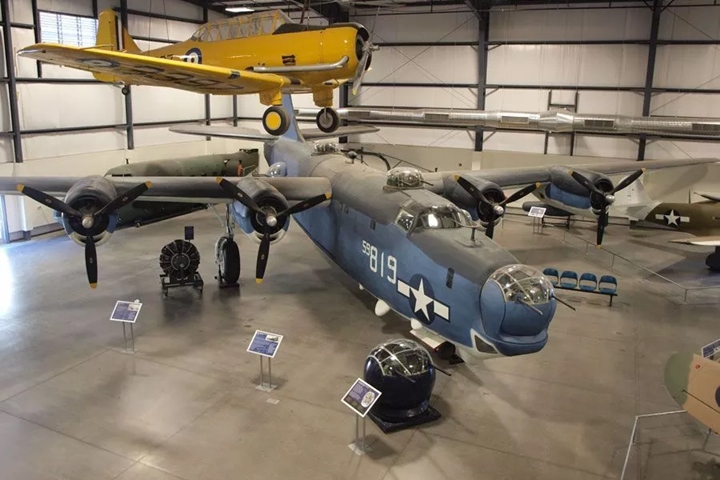
This is a current state of the same PB4Y-2
as shown above. It is now on display at the Pima Air and Space
Museum in Tucson, AZ. An ERCO ball turret is also on display next
to the aircraft. This image also shows the two top turrets in the
aircraft. Image courtesy of the Pima Air and Space Museum.
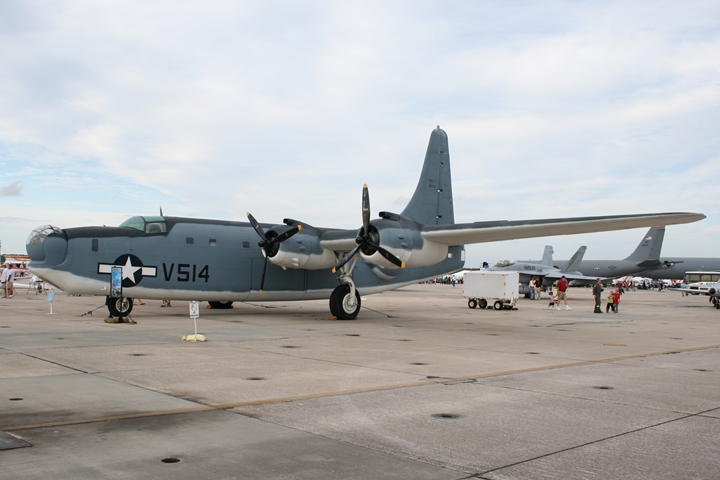
The National Museum of Naval Aviation in
Pensacola, FL has a PB4Y-2 in its collection. Author's photo.
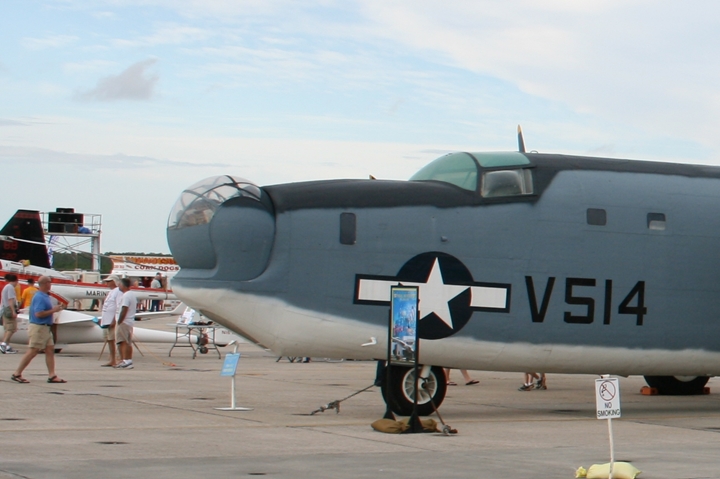
The aircraft still has the ERCO bow turret
installed in it. Author's photo.
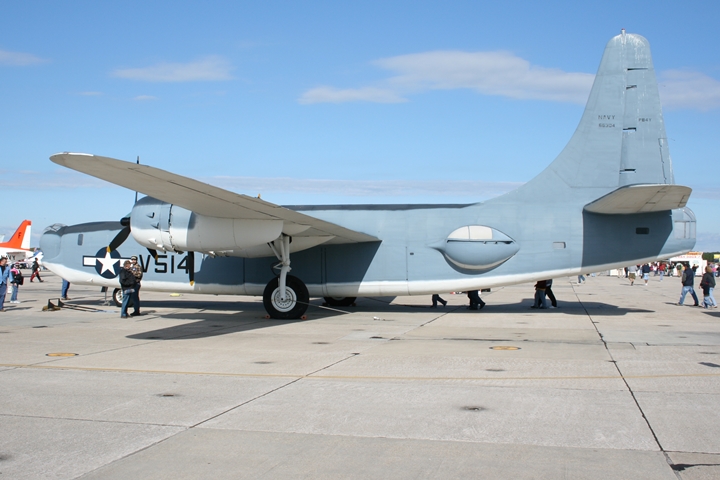
The tall vertical stabilizer is easily seen in this image. Author's photo.
The next series of photos is of the PB4Y-2 on display at the
Yankee Air Museum in Bellevue, MI.
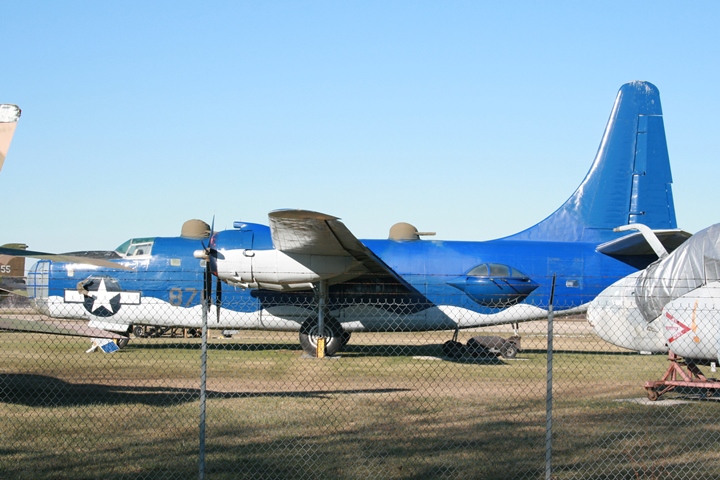
In 2008 the aircraft had a bright blue paint
scheme. The dorsal turrets and the side 250TH-2 turret can be
seen. Author's photo.
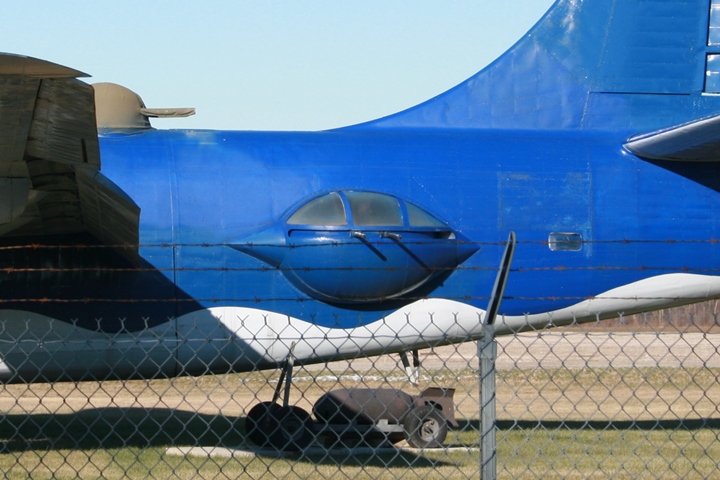
Author's photo.
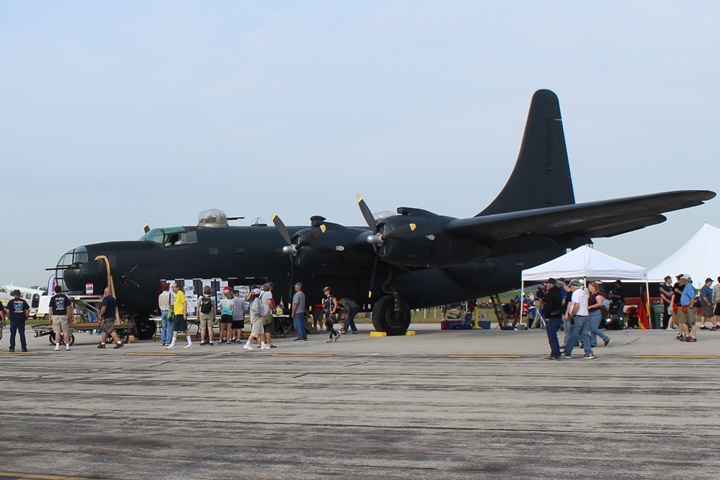
The same aircraft was on display at the
Yankee Air Museum's 2015 Thunder over Michigan Airshow. It had
been painted in the all dark blue paint scheme that the U.S. Navy
introduced in late World War Two. Author's photo.
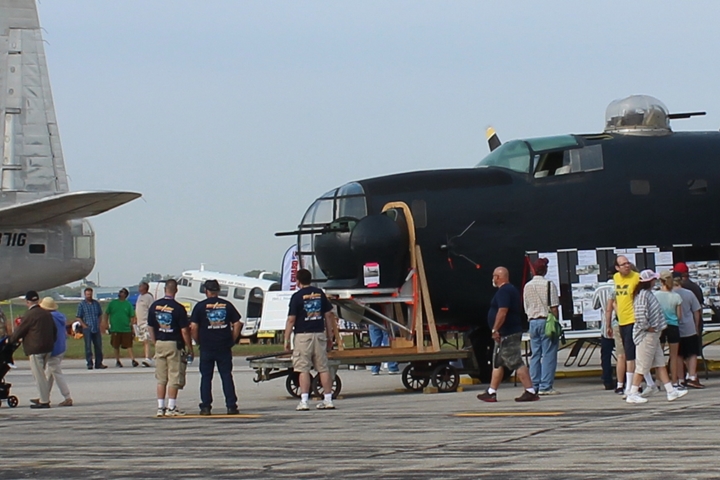
The display also included the bottom half of
an ERCO bow turret. The front Martin dorsal turret can also be
seen. Author's photo.
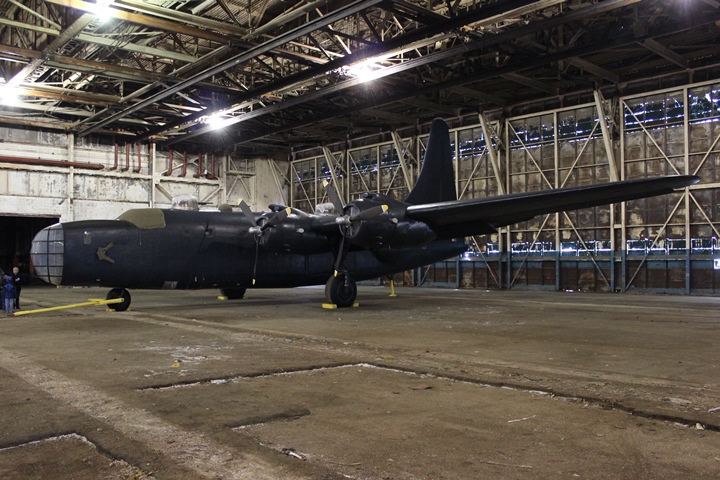
In 2016 the aircraft had been moved into the
last remaining building of the former World War Two Ford B-24 plant.
Author's photo.
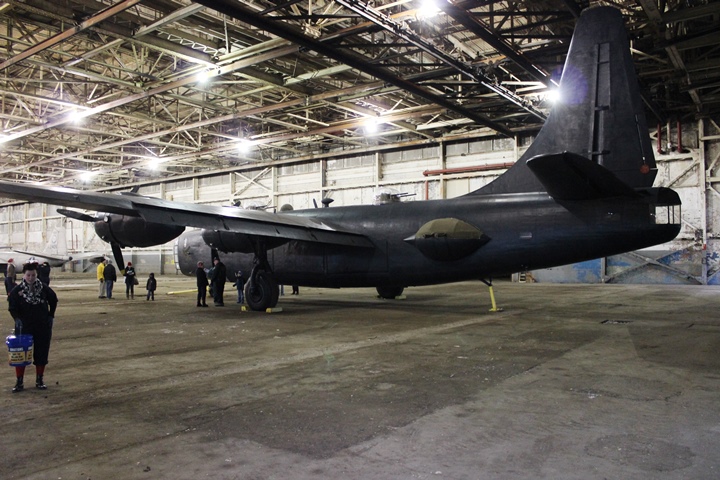
Author's photo.
Post-World War Two Products:
ERCO's main post-World War
Two products were flight simulators for military aircraft. It built
simulators for the F9F, F-86D/K, P2V-5, F4D, A3D, AD5N, RB-66, S2F,
KC-135, P5M and F-105. It also built a flight simulator for the
ZP4K Goodyear blimp. Another related product was submarine
simulators.
Below are photos of the type of aircraft for which ERCO built flight simulators.
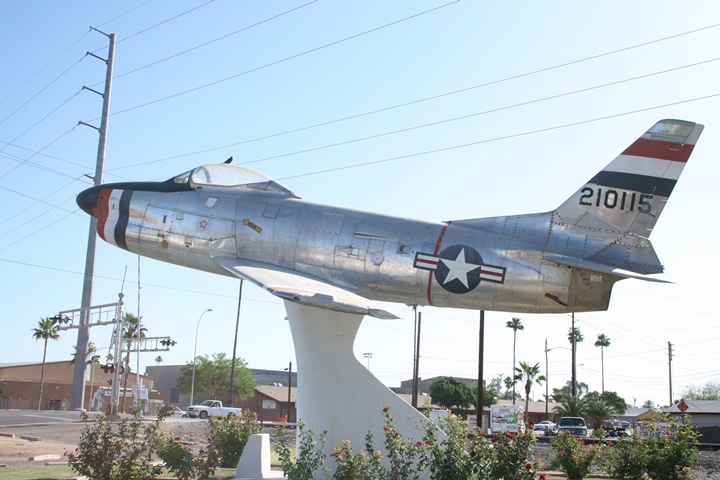
ERCO built 66 flight simulators for the
F-86D/K. Author's photo.
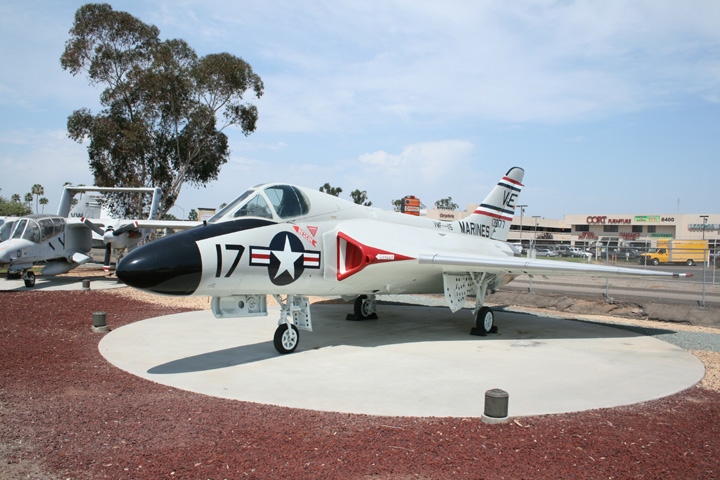
F4D. Author's photo.
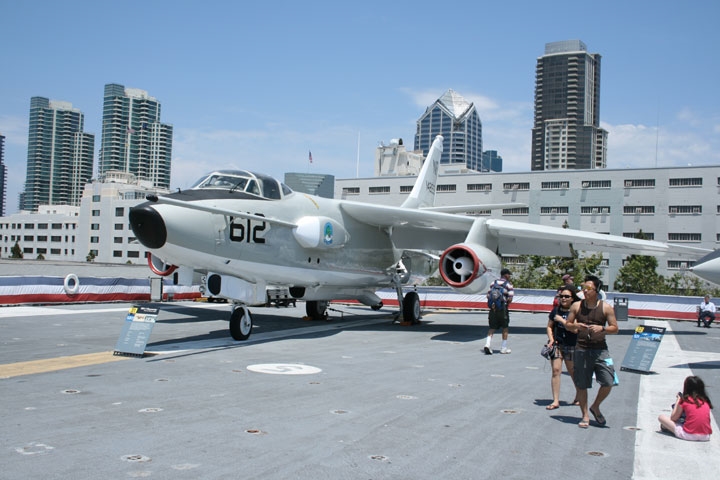
A3D. Author's photo.
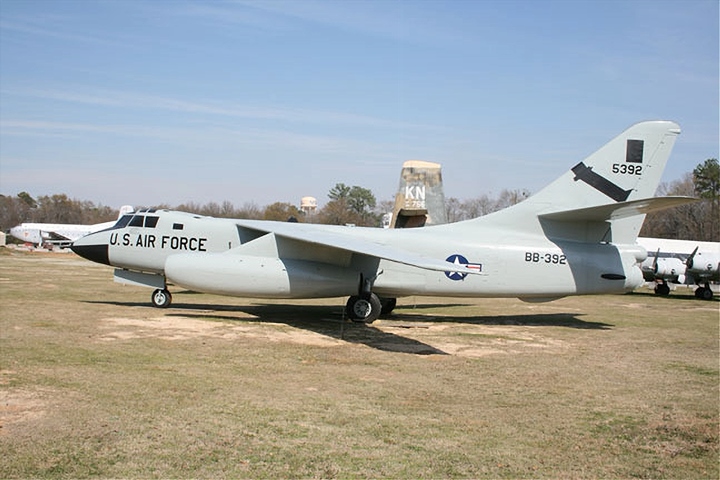
The RB-66 is the Air Force's version of the
Navy's A3D. Author's photo.
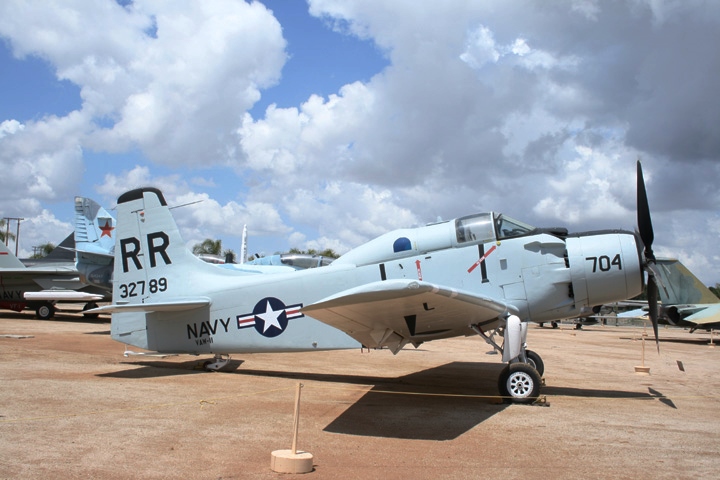
AD5. Author's photo.
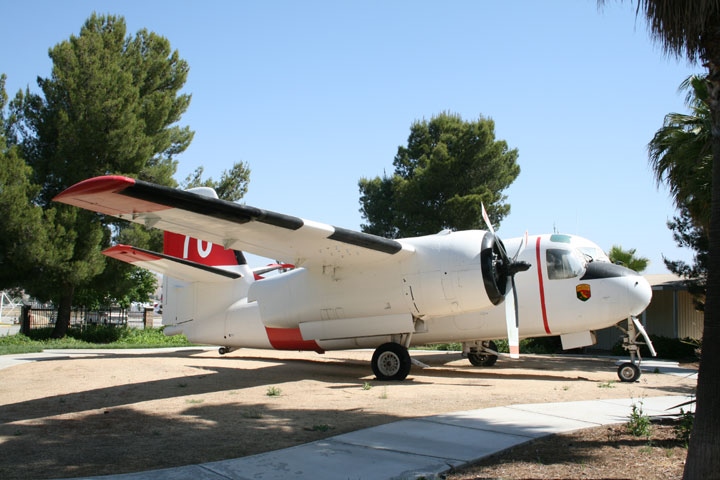
S2F. Author's photo.
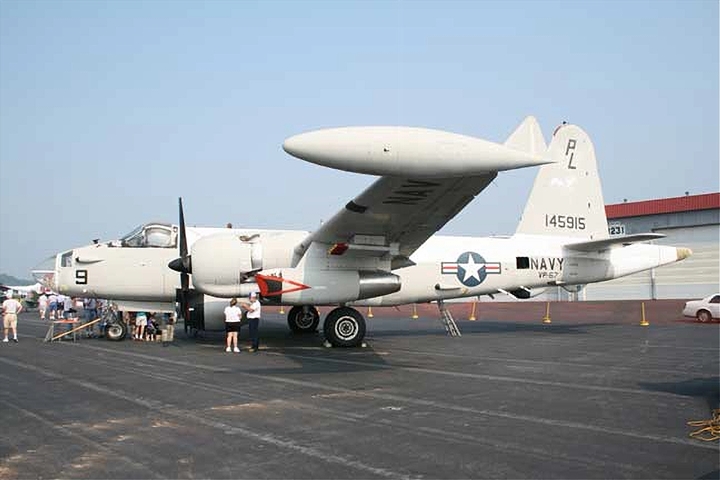
P2V. Author's photo.
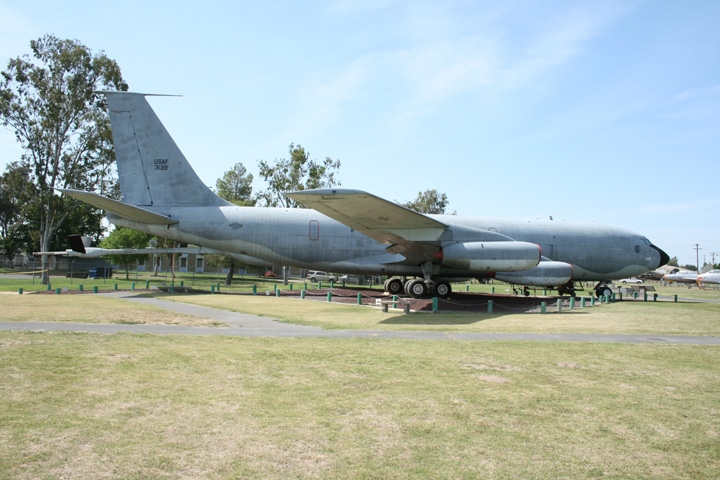
KC-135. Author's photo.
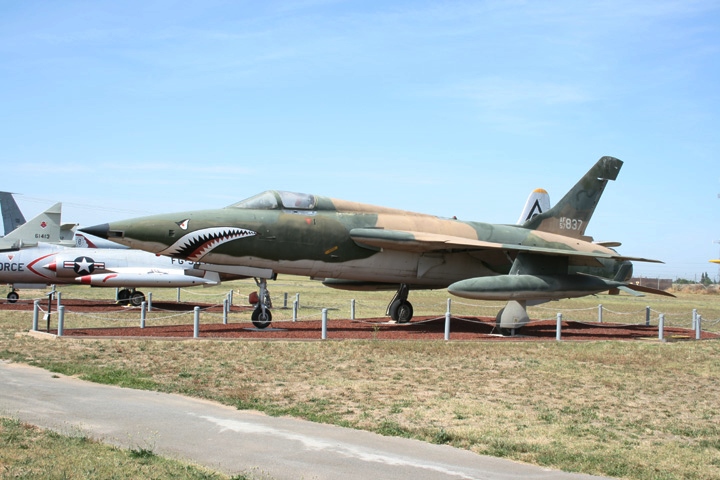
F-105. Author's photo.
|


































